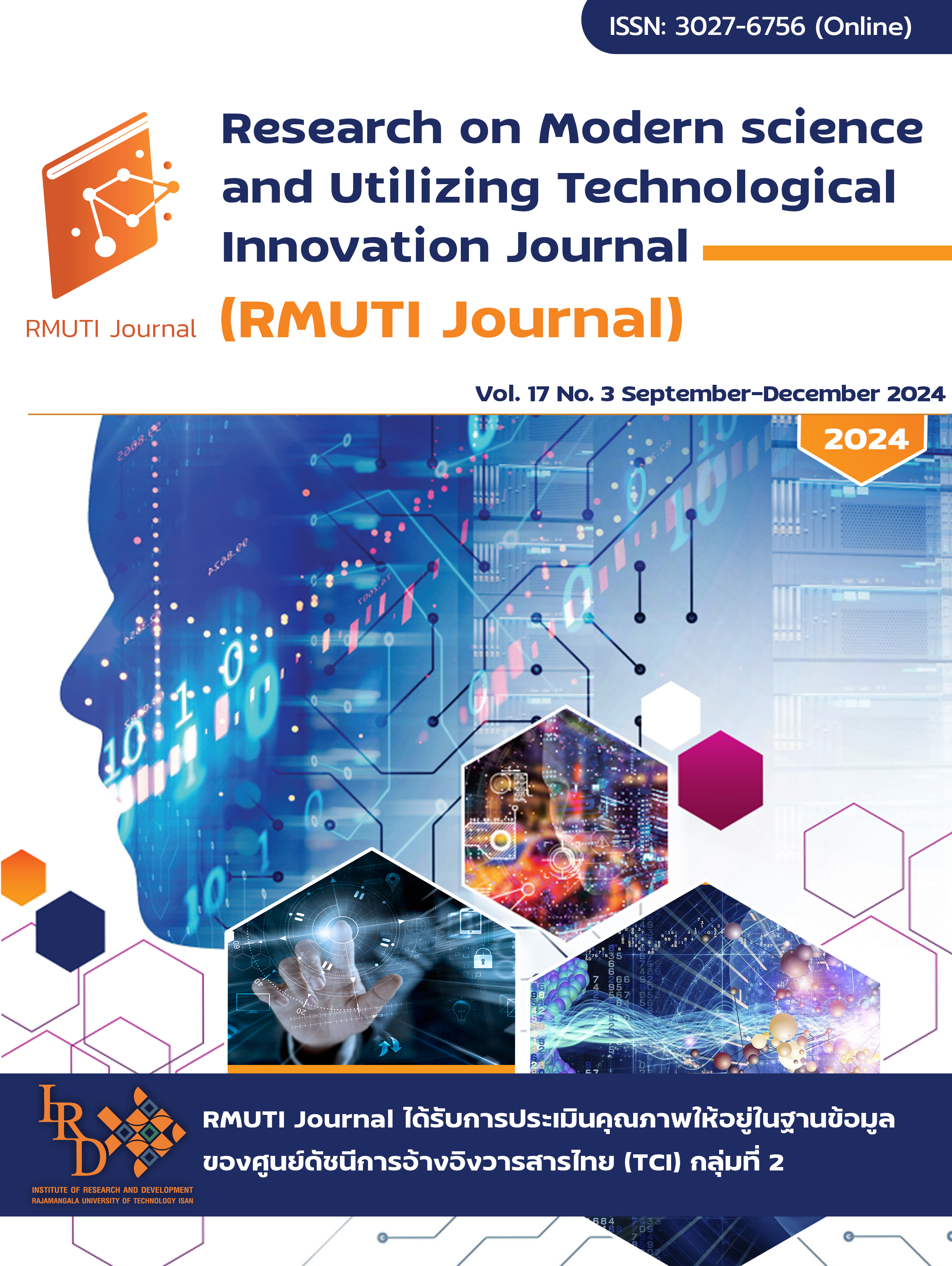ผลของวัสดุปลูกต่อการเจริญเติบโตและผลผลิตของคะน้าใบหยิก
Main Article Content
บทคัดย่อ
งานวิจัยนี้มีวัตถุประสงค์เพื่อศึกษาผลของวัสดุปลูกต่อการเจริญเติบโตและผลผลิตของต้นคะน้าใบหยิกวางแผนการทดลองแบบ Completely Randomized Design (CRD) จำนวน 9 สิ่งทดลอง จำนวน 4 ซํ้า ดังนี้ 1) ดินร่วนปนทราย:มูลโค อัตราส่วน 1:2 2) ดินร่วนปนทราย:ขุยมะพร้าว:มูลโค อัตราส่วน 1:1:2 3) ดินร่วนปนทราย:แกลบดิบ:มูลโค อัตราส่วน 1:1:2 4) ดินร่วนปนทราย:แกลบดิบ:ขุยมะพร้าว:มูลโค อัตราส่วน 1:1:1:2 5) ดินร่วนปนทราย:มูลสุกร อัตราส่วน 1:1 6) ดินร่วนปนทราย:ขุยมะพร้าว:มูลสุกร อัตราส่วน 1:1:1 7) ดินร่วนปนทราย:แกลบดิบ:มูลสุกร อัตราส่วน 1:1:1 8) ดินร่วนปนทราย:แกลบดิบ:ขุยมะพร้าว:มูลสุกร อัตราส่วน 1:1:1:1 9) ดินร่วนปนทราย:ขุยมะพร้าว:ปุ๋ยมูลโค:แกลบดิบ:ปุ๋ยสูตร 16-16-16 อัตราส่วน 1:2:1:1:0.25 จากผลการศึกษาพบว่า สิ่งทดลองที่ 2 มีการเจริญเติบโตของคะน้าใบหยิก ด้านความสูง ความกว้างทรงพุ่ม จำนวนใบ ความกว้างและความยาวของใบ มากที่สุดคือ 10.13 เซนติเมตร 21.17 เซนติเมตร 6.67 เซนติเมตร 14.00 ใบ และ 8.83 เซนติเมตร ตามลำดับ และให้ผลผลิตด้านนํ้าหนักสดต้นรวมราก 33.84 กรัม และนํ้าหนักราก 31.85 กรัม มากที่สุด ดังนั้น วัสดุปลูกที่มีส่วนผสมของดินร่วนปนทราย:ขุยมะพร้าว:มูลโค ในอัตราส่วน 1:1:2 มีความเหมาะสมกับการปลูกคะน้าใบหยิกมากที่สุด
Article Details

อนุญาตภายใต้เงื่อนไข Creative Commons Attribution-NonCommercial-NoDerivatives 4.0 International License.
เอกสารอ้างอิง
Chantharawan, W. (2022). The Queen of Green. Access (17 January 2023). Available (https://kb.mju.ac.th/article.aspx)
Suksawat, M. (2004). Handbook of Flower Agriculture and Media for Ornamental Plants. Bangkok: House and Garden
Gruda, N. (2009). Do Soilless Culture Systems Have an Influence on Product Quality of Vegetables? Journal of Applied Botany and Food Quality. Vol. 82, No. 2, pp. 141-147 (in Thai)
Kasemsap, S. (1983). Potted Flowering Plants. (2nd ed.). Bangkok: Kasetsart University
Wattanaphayapkul, V. (2015). Effects of Wood Vinegar and Manure on Growth, Yield and Seed Quality of Hom Mali Rice. Journal of Agriculture. Vol. 31, No. 3, pp. 269-279 (in Thai)
Wongkrachang, S. (2014). Effects of Organic and Inorganic Fertilizer for Maize Growth on Ban Thon Soil Series. Khon Kaen Agriculture Journal. Vol. 42, pp. 359-362 (in Thai)
Tuwaihan, S., Phairawan, K., Jantasri, R., and Pimrach, S. (2013). Study on Suitable Soil Mix for Chinese Kale Cultivation. Prawarun Agricultural Journal. Vol. 10, No. 2, pp. 117-124 (in Thai)
Suksamran, C. (2020). Effect of Growing Media on Growth and Potential of Linharn (Launaea sarmentosa) Production in Phuket Province. Khon Kaen Agriculture Journal. Vol. 48, No. 3, pp. 509-514 (in Thai)
Suksawat, M. (2017). Organic Fertilizer: Revised Edition. SE-ED Publishing, Bangkok
Kunlanit, B., Pidtaraso, S., and Siritrakulsak, T. (2021). Effects of Type and Rate of Organic Fertilizers on Growth, Yield and Net Economic Return of Chinese Kale Production. Khon Kaen Agriculture Journal. Vol. 49, No. 3, pp. 538-550. DOI: 10.14456/kaj.2021.xx
Anuwong, C., Kosinwattana, S., and Marongchai, S. (2020). Effect of the Growing Media and Manure Types on Growth and Development of Episcia cupreata (Hook.) Hanst. King Mongkut’s Agricultural Journal. Vol. 38, No. 3, pp. 304-314 (in Thai)


